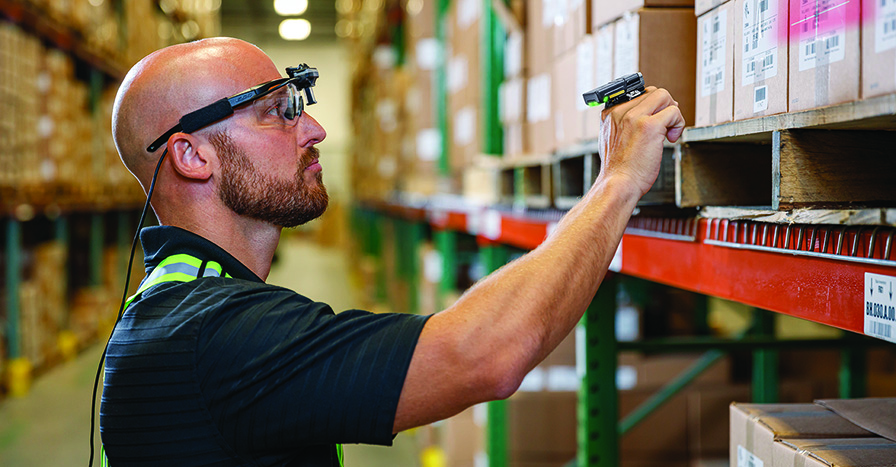Labor Management: Stuff that works
There’s been more than enough whining about the availability and stability of labor in DCs and warehouses. Ignoring that path, about a third of facilities have put in place tools and practices that motivate and engage people. Everyone else has no choice but to follow or fall behind.
Talk to people about the current state of labor in warehouses and DCs, and you might be surprised by what they have to say. The conversation has changed lately, but not in the way you’re hoping.
There aren’t suddenly more people than jobs. Wages are not declining. Four generations will continue to be in the workforce. People are just as restless, often for a small increase in pay. And you shouldn’t expect any of that is going to morph anytime soon.
In fact, a Zebra Technologies’ “2024 Warehousing Vision Study,” which surveyed about 1,400 IT and operations decision makers, pegs labor recruitment as their second biggest challenge in the next five years, says Mark Wheeler, director of supply chain solutions at Zebra.
But instead of complaining about those conditions, DC leaders are focused now on ways to work differently. Freshly defined work standards, more frequent performance assessments, flexible scheduling, managing peaks differently and new compensation schemes are recurring themes. And so are wearable tech, behind-the-scenes software and improvements to the building’s environment.
Clearly, labor management has become an incremental game of continuous improvement. It’s the only option as the world moves to a more labor-intensive workplace as eaches ramp up and pallet loads ramp down.
How well are DCs doing?
“Warehouse work is generally tough work for relatively low pay,” says Dan Gilmore, chief marketing officer at Softeon. Furthermore, he adds, “the level of connectedness also varies significantly across warehouses, with workers more valued in some facilities and viewed more as commodities in others, which drives turnover.”
Successful labor management is all about motivating people, says Peter Schnorbach, senior director of product management at Manhattan. And the point is not labor management, he adds, as much as it is tapping into the three key desires that motivate anyone working in a DC (or anyplace else for that matter): autonomy, mastery and connectedness. Those three factors keep people engaged, the most important manifestation of successful labor management.
That said, about a third of DCs are doing a good job of labor management, says Chris Slover, vice president of sales at Fortna. He adds that leaders do an adequate job of labor management, but a significant number of laggards could benefit from improvements in this area.
Slover and others agree that it isn’t difficult to see immediately if labor management is effective. If it is, housekeeping is in order. Equipment and inventory are where they should be. Maintenance is current. And perhaps most importantly, people move at a good pace and are engaged with others.
“You can actually see a motivated workforce just walking through the facility,” says Jon Kuerschner, HighJump’s vice president of supply chain consulting. “One of the best signs is people are not constantly going back to their supervisor for their next assignment. Self-directed, engaged people is what you’re after,” says Kuerschner.
However, all this is often easier said than done. “Ask anyone if they want to talk about labor issues, and everyone is in,” says Slover. “They may be thinking about it, but they aren’t always engaged (a recurring word on both sides of the labor equation) in dealing with the issues. And, those people usually have an excuse such as tight budgets or light staffing to explain away deficiencies,” Slover adds.

Head and wrist displays direct work assignments to people and update them on performance.
To that point, Zebra’s Wheeler says the survey mentioned earlier puts labor efficiency and productivity as only the third largest challenge over the next five years.
That’s a surprisingly low priority for what is probably a DC’s greatest expense: Labor. “Labor accounts for 60% to 70% of warehouse costs,” says Steve Simmerman, senior director at Blue Yonder, previously known as JDA Software. Which brings us to the question: How do you get the most benefit from that cost?
“The two key metrics to watch in a DC today are waste and quality, says Simmerman. “Waste shows up as excess cost, lower productivity and poor employee retention. Poor work quality such as order fulfillment inaccuracies also increases waste,” adds Simmerman.
Fortunately, that Zebra survey puts capacity utilization and order accuracy, two strong indicators of waste and quality, as the top two challenges going forward. That’s a positive indicator for future improvements in labor management. Not only is there room for improvement, but it is recognized as necessary.
What can you do?
The first thing you can do is simply look around. And, not necessarily internally.
What are Walmart and Starbucks doing to tap the labor pool? Target and McDonalds, too. In the most general sense, all of these companies are going after the same workers in a given area just like warehouses and DCs. Experts interviewed for this story typically pointed this out, saying retailers of all stripes are your competition for labor.
“If you’re not doing something comparable to what these companies are doing from pay to scheduling, then you’re way behind,” says Simmerman.
Bryan Jensen, chairman and executive vice president at St. Onge, points out that labor competition is even more intense in areas with multiple DCs and warehouses. The seasonality of warehouse work doesn’t make this any easier.
One trend Jensen identifies is third-party logistics (3PL) providers building what he calls campuses of DCs. In a relatively small region or area, the 3PLs may well build multiple buildings. Historically, labor was devoted to a single building. Not necessarily any longer. Instead, as seasonality and peaks work their way through the year, labor is moved from building to building based on needs. That helps stabilize the workforce.
An important aspect of that mix is scheduling. At its heart, scheduling flexibility is a key step toward worker autonomy. For instance, Sue and Bob may have always worked first and second shift, respectively. However, that may no longer fit their lives outside of the DC.
“Managers today need to build flexibility into scheduling,” explains Manhattan’s Schnorbach. Both software and a management approach that accommodates flexibility and even self-scheduling are effective today, he says.
Talk to Kuerschner of HighJump and he sees this as a clear trend. “About 25% of companies are either using this scheduling capability now or are interested in using it. There’s probably going to be another uptick in interest here in 2020. This capability is becoming the expectation,” he adds.
Scheduling flexibility is also a trend that can benefit workload management. As Kuerschner explains, scheduling flexibility software also allows the DC to more easily tailor the workforce and its specific skills to the workload. That minimizes waste and improves quality.
Simmerman says the more that can be done to put scheduling decisions in the hands of employees, the more effective this aspect of autonomy becomes. But it doesn’t have to be complicated. Slover of Fortna says flexible scheduling could be as simple as building in a 15-minute buffer to measure on-time attendance.
Needless to say, pay is critical here, too. And it’s more than just being competitive with Target and the others. The real trick is to offer pay packages that not only motivate people but result in stability/retention resulting in productivity that ultimately benefits warehouse operations.
This is an opportunity for creativity, experts agree. There is no magic number, but find what works at your DC, and the results can be magic.
It could be a $3 an hour bonus for people who come in eight days in a row during an especially difficult peak period. It could be an incentive for orders that ship without rework. It could be as simple as a higher hourly wage than any other employer drawing from that labor pool. It could be a four-day work week. There’s also the possibility of good old-fashioned pay for performance.
Rating job performance
The key to rating job performance is still work standards. But they are changing, explains Gilmore at Softeon. “Many companies are reluctant to invest in the cost of developing and maintaining full engineered standards,” says Gilmore.
The alternative is to use a more statistical approach to setting productivity goals. “Using that approach, you get about 80% of the benefit for 20% of the cost,” explains Gilmore. He also notes the use of simulation to analyze required work versus labor capacity to provide advanced labor planning.
Simmerman points out that artificial intelligence (AI) is starting to work into the labor management software equation. “AI is getting more predictive in labor and ultimately more prescriptive,” he says. In other words, AI can provide insight into future needs based on past experiences. It’s already helping managers determine where and what kind of labor is necessary for a given set of order fulfillment conditions.
The flip side here is rating workers. People really do want to know their level of mastery of the job at hand. Some, millennials, in particular, would like to know how they’re doing on a daily basis. Slover of Fortna says 60% of people want weekly input at the least.
Furthermore, everyone wants to know how they can improve. However, all of that requires extensive time from managers. Time they may not have.
Alternatives to one-on-one meetings include smart phones, kiosks and other types of data terminals including wearable tech that can update the employee on performance against set metrics. Wheeler of Zebra talks about head- and wrist-worn displays that can direct work assignments and update people on their performance.

High frequency one-on-one coaching is a strong labor management tool.
The idea, he says, is to connect people to data directly. It’s called edge computing and eliminates the lag time needed to connect to the Cloud. This puts computing power right at the point of activity, maximizing effectiveness and timeliness.
While edge computing is one form of connectedness, the other is connect to other workers. “People love teams not just their own individual performance. In fact, teams are a major driver of DC performance today,” says Schnorbach.
People want to know how their team is performing. “The best approach is to recognize the team, reinforce its performance and reward it,” says Schnorbach. Rewards here range from lunch for the team to special parking and even money.
Don’t forget about the building
Where people work matters, too. Air quality, water availability and light abundance are all key, says Slover. That requires attention to HVAC, water stations including ones designed for filling water bottles and bright lighting especially in work areas.
Other areas worth improving include breakrooms, cafeterias, locker rooms and patios (firepits are not a bad idea). Parking, especially distance to the facility, also matters, Slover says. “All of these physical aspects of the DC demonstrate engagement on the part of management and a supportive culture in the workplace,” he adds.
As Schnorbach points out, labor used to be a mere commodity and labor management was very binary. But now more creative approaches to hiring and retention are needed and possible. Fortunately, there are plenty of options ready to go today.













